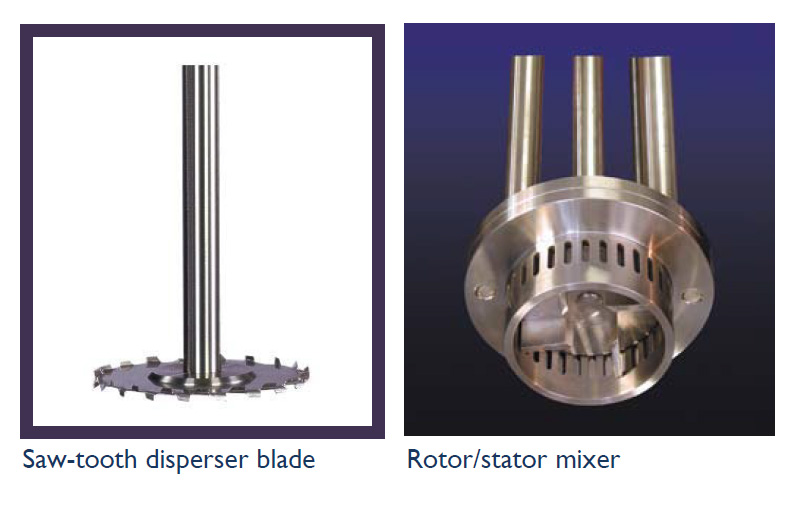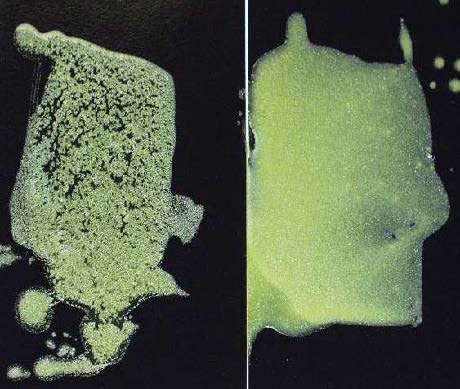Tech Report
High Speed Mixing: Saw-tooth Dispersers vs. Rotor/stator Mixers

Technology Brief
The saw-tooth disperser and rotor/stator mixer are two of the most widely used high speed mixers yet many are unaware of the differences in their utility and operating capacities. Knowing the unique attributes of these devices is important in mixer selection and process optimization.
High speed mixing
High speed mixing is often required when incorporating solids into liquid especially when the powders are difficult to wet out, or when large amounts of solids are involved. Mixing under high shear and turbulent flow conditions is also ideal for particle size reduction, emulsification and homogenization. In many industries, saw-tooth dispersers and rotor/stator style mixers are used to accomplish high speed mixing.
Pumping capacity and shear
Running at tip speeds of around 5,000 ft/min, a saw-tooth disc-style disperser creates vigorous flow within the mix vessel and imparts greater shear compared to other open-blade mixing devices such as propellers or turbines. It generates a vortex into which solids can be added for quick incorporation into the batch. Dispersers are typically used in applications up to around 50,000 cP in viscosity.
In comparison, a rotor/stator mixer typically features a four-blade rotor running at tip speeds in the range of 3,000-4,000 ft/min within a close tolerance fixed stator. This type of device creates mechanical and hydraulic shear by continuously drawing product components into the rotor and expelling them radially through the openings in the stator. Because of the restriction provided by the stator, this mixer offers higher shear but less pumping capacity than an open-disc saw-tooth disperser blade. For the same reason, its viscosity limit is lower - around 10,000 to 20,000 cP. The rotor/stator mixer is available in both batch and inline (continuous) designs.
Typical uses and applications
The saw-tooth disperser is a standard workhorse used in the manufacture of paints, inks, chemicals, plastics, adhesives and other products. It is an economical and simple piece of mixing equipment with the primary purpose of incorporating powders into liquid and breaking down agglomerates to produce a stable dispersion. Often, it functions as a "pre-mixer" wherein the resulting mixture is further processed or milled in a downstream polishing step to produce the final dispersion.
The rotor/stator is more commonly used for emulsification and particle size reduction due to the high shear conditions it develops. It is important to note that this reduction of "particle size" most commonly includes the breakdown of agglomerates and not necessarily of individual particles. Except with highly friable materials, it is rarely the case that primary particles are broken down in a rotor/stator mixer, even in special ultra-high shear designs that run up to 11,000-18,000 fpm.
Certain rotor/stator mixers are equipped for sub-surface powder induction which simplifies material handling and eliminates issues of floating powders and dusting in the plant atmosphere. This method of high speed mixing is ideal for processing solids that tend to form lumps or "fish eyes" upon contact with liquid.
Look for versatility

In an R&D setting, it is often useful to have a multi-purpose mixing tool designed for interchangeable agitators that can be swapped easily. Ross laboratory mixers are offered with different size disperser blades and a rotor/stator assembly with different style stators. Increasing mixer versatility extends the spectrum of tests that a single unit can accomplish in the laboratory.
Sample Application: Pigmented Epoxy Coating

Dispersions of inorganic pigment in epoxy using a Dual-Shaft Mixer with anchor agitator and saw-tooth disperser (left) and using a Triple-Shaft Mixer with anchor agitator, saw-tooth disperser and rotor/stator (right). Use of the rotor/stator mixer delivered a more superior pigment dispersion and color development.